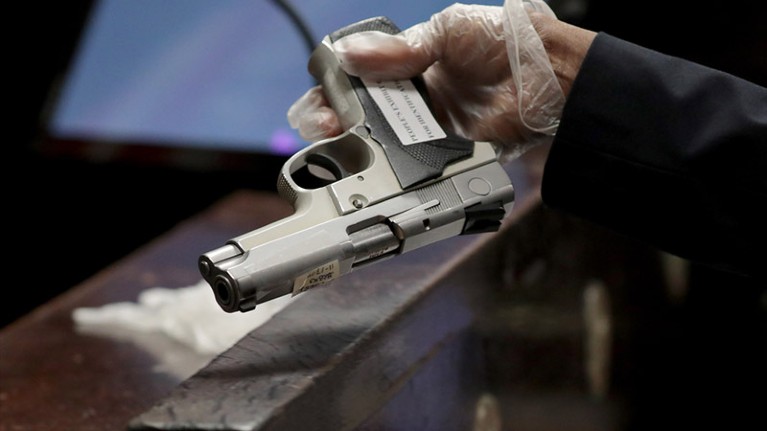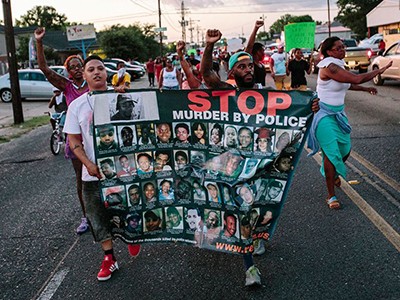
In the United States, the reporting of deaths from police shootings is voluntary.Credit: Antonio Perez/Chicago Tribune/Getty
On an August afternoon this year in the Nicetown neighbourhood of Philadelphia, Pennsylvania, city police engaged in a horrific gun battle with a 36-year-old man. He had an extensive criminal history and copious ammunition. Six officers were shot and wounded in an ordeal lasting more than seven hours. Miraculously, not a single life was lost, and the man was taken into custody shortly after midnight.
That no one was killed was a testament to the bravery and patience of law-enforcement officers whose daily work involves huge risks. In 2018, 51 police officers in the United States were shot and killed in the line of duty; 4 were killed by other means; and another 51 died in accidents. The FBI keeps detailed data on officer deaths, as do a handful of other organizations interested in memorializing and recognizing their fallen colleagues.
But, in contrast to police officer deaths, getting clear data on the number of civilians killed by police has been much more difficult, as Nature found while investigating data sources on police violence in the United States for a news feature published this week.
What the data say about police shootings
Some of the country’s 18,000 police departments maintain detailed records. But nationwide, the coverage by official agencies has been dismal. In the past five years, a handful of news organizations and individuals have begun to fill in the gaps by collecting all available public records on killings by police in the United States.
The counts they’ve provided are surprising: more than 1,000 people die each year at the hands of the police. This number greatly exceeds annual deaths attributable to law enforcement in other wealthy nations. In the United States, moreover, people from ethnic minority groups are killed at a higher rate than white people. A study released this year suggests that the risk of death from a police encounter for a black man is 2.5 times that for a white man (F. Edwards et al. Proc. Natl Acad. Sci. USA. 116, 16793–16798; 2019).
That study and others like it are based on incomplete and unofficial figures patched together from many sources. They may be missing data, and certainly don’t have clear and comparable details surrounding each deadly encounter. That, however, could change. In a long-awaited move, the FBI began this year to collect data on police shootings systematically to enhance the transparency of law enforcement at a national level. But this effort falls short: the agency does not require local police departments to report their figures. Data recording is voluntary, when it should be mandatory.
More robust research on policing practice could help to determine why some cities with similar crime rates and population demographics have vastly different numbers of civilians and officers killed. Research could also reveal what kinds of intervention are effective, for example, whether the use of body cameras by police officers reduces deaths; and why people from ethnic minority groups are being disproportionately killed. But for now, the necessary data sources are not being accessed.
One solution is to make federal grants to local agencies contingent upon compliance with more comprehensive data reporting. But mandating compliance is politically fraught. Data collection needs to be properly resourced — although law-enforcement agencies will contend that, if additional funding can be found, it should be used to fund actual police work and not what used to be called pen-pushing. Moreover, agencies are concerned that full reporting could open their departments to unwarranted criticism.
Such arguments, however, do not hold. Effective policing depends on trust between officers and the communities they serve. Transparency is key to law-enforcement organizations building, or regaining, that trust — and, in particular, the trust of minority communities. Earning trust is more likely if officers are completely open about when, where, how and why they use deadly force — and when, despite all odds, they are able to escape fraught encounters without incurring fatalities, as they did in Philadelphia last month.

 What the data say about police shootings
What the data say about police shootings
 Firearms research: The gun fighter
Firearms research: The gun fighter
 Fight the silencing of gun research
Fight the silencing of gun research






